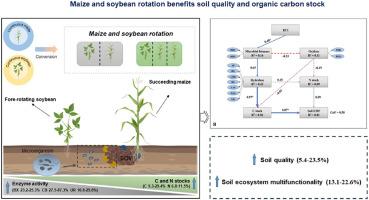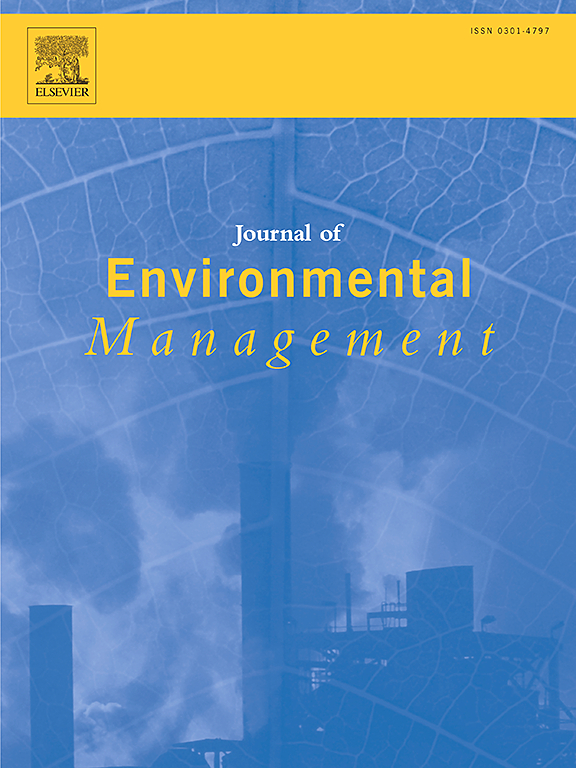玉米和大豆轮作有利于提高土壤质量和有机碳储量。
IF 8.4
2区 环境科学与生态学
Q1 ENVIRONMENTAL SCIENCES
引用次数: 0
摘要
大豆和玉米轮作被推荐为一种有前途的策略,可使作物产量最大化。然而,大豆-玉米轮作,尤其是大豆加入的频率对土壤质量和碳储量的影响仍有待探讨。我们在中国东北地区进行了为期 8 年的随机设计田间试验,试验采用了四种种植制度,即大豆连作(S)、玉米连作(M)、大豆-玉米轮作(SM)和大豆-玉米-玉米轮作(SMM)。结果表明,轮作(SM 和 SMM)下的土壤质量指数、土壤生态系统多功能性(EMF)和碳储量分别比连作(M 和 S)下的土壤质量指数、土壤生态系统多功能性和碳储量高 5.4-23.5%、13.1-22.6% 和 9.3-29.4%。值得注意的是,与连作相比,大豆-玉米轮作减轻了微生物对氮(N)的限制,这是由于酶的活性刺激了C、N和P的获取。此外,土壤质量指数与表土中的碳储量呈正相关。土壤有机碳和全氮的积累率在 SMM 中分别比在 SM 中高 0.39 和 0.14 g kg-1 year-1。因此,在大豆和玉米轮作中,科学的大豆频率是提高土壤有机碳的有效方法。总之,与单作相比,大豆-玉米轮作能改善土壤质量,减少轮作中大豆的种植频率(SMM)有利于C和N的储存。本文章由计算机程序翻译,如有差异,请以英文原文为准。

Maize and soybean rotation benefits soil quality and organic carbon stock
Soybean and maize rotation has been recommended as a promising strategy to maximize crop yield. However, the impacts of soybean-maize rotation, and particularly the frequency of soybean inclusion, on soil quality and carbon (C) stock need to explored. We conducted an 8-year field experiment of randomized design in Northeast China with four cropping systems as continuous soybean (S), continuous maize (M), soybean-maize rotation (SM), and soybean-maize-maize rotation (SMM). The results showed that the soil quality index, soil ecosystem multifunctionality (EMF), and C stock under crop rotation (SM and SMM) were 5.4–23.5%, 13.1–22.6%, and 9.3–29.4% higher than those under continuous cropping (M and S), respectively. Additionally, the increased frequency of soybean in the rotation increased soil EMF by 14.8% due to higher soil enzyme activities and available N. Notably, the soybean-maize rotation alleviated microbial nitrogen (N) limitation compared to continuous cropping, due to stimulated C, N, and P acquisition by enzyme activities. Furthermore, the soil quality index correlated positively with C stock in the topsoil. The accumulation rates of soil organic C and total N were higher by 0.39 and 0.14 g kg−1 year−1 in SMM than in SM, respectively. Therefore, scientifically based soybean frequency is an effective approach to enhance soil organic C in soybean and maize rotation. In conclusion, soybean-maize rotation improves soil quality compared to monoculture, and a reduced frequency of soybean within the rotation (SMM) is beneficial for C and N storage.
求助全文
通过发布文献求助,成功后即可免费获取论文全文。
去求助
来源期刊

Journal of Environmental Management
环境科学-环境科学
CiteScore
13.70
自引率
5.70%
发文量
2477
审稿时长
84 days
期刊介绍:
The Journal of Environmental Management is a journal for the publication of peer reviewed, original research for all aspects of management and the managed use of the environment, both natural and man-made.Critical review articles are also welcome; submission of these is strongly encouraged.
 求助内容:
求助内容: 应助结果提醒方式:
应助结果提醒方式:


